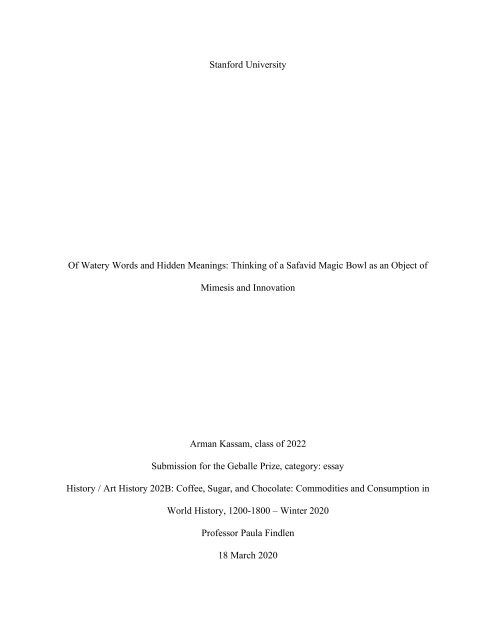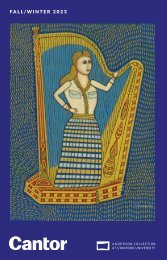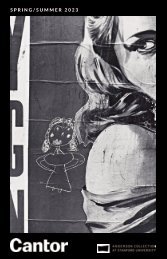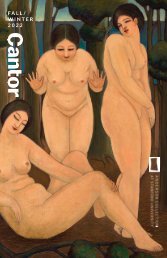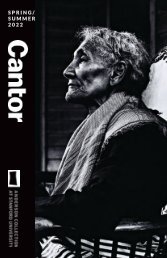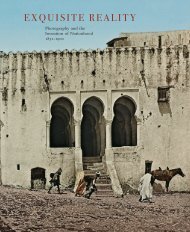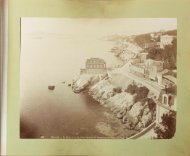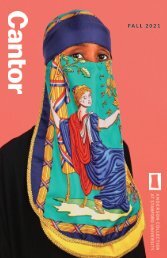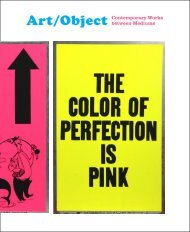You also want an ePaper? Increase the reach of your titles
YUMPU automatically turns print PDFs into web optimized ePapers that Google loves.
Stanford University<br />
Of Watery Words and Hidden Meanings: Thinking of a Safavid Magic Bowl as an Object of<br />
Mimesis and Innovation<br />
<strong>Arman</strong> <strong>Kassam</strong>, class of 2022<br />
Submission for the <strong>Geballe</strong> <strong>Prize</strong>, category: essay<br />
History / Art History 202B: Coffee, Sugar, and Chocolate: Commodities and Consumption in<br />
World History, 1200-1800 – Winter <strong>2020</strong><br />
Professor Paula Findlen<br />
18 March <strong>2020</strong>
1<br />
Of all the European accounts of the Safavid Empire, the writings of the Huguenot jeweler<br />
Jean Chardin might just be our best window into everyday life in the Empire. Having traveled<br />
extensively throughout modern-day Iran as a royal merchant to Shah Abbas II, Chardin<br />
eventually settled in England in the late 1680’s and began compiling his Voyages, an<br />
embellished record of his life abroad. 1 In one English translation of this record, Chardin<br />
mentions something peculiar about the religious customs of the Safavids: “They believe that all<br />
Men’s Prayers are good and prevalent; therefore, in their illnesses, and in other Wants, they<br />
admit of, and even [use] the Prayers of different Religions: I have seen it practis’d a Thousand<br />
Times.” 2 We should be careful not to take his claims of religious plurality – something he’s seen<br />
“a Thousand Times” – at face-value, but Chardin still captures the spirit of religious life in<br />
Safavid Persia as it intersected with popular medicine. In times of grave illness or epidemic,<br />
Turk and Tajik alike found recourse in a diversity of religious remedies. One such remedy is<br />
connected to an inconspicuous artifact in Stanford University’s Cantor Center: an earthenware<br />
bowl with astrological designs and encircling script, dated to sixteenth-century Persia (fig. 1, fig.<br />
2, fig. 3). This item likely belonged to a magic bowl culture that facilitated spiritual blessings for<br />
the ailing and sinful. Today, these bowls are disproportionately represented by ornately<br />
engraved, prestigious metal objects that belonged to only a minority of political and merchant<br />
elites. The Cantor Center holds what may be one of the few existing Islamic magic bowls that<br />
was crafted from unglazed clay and, by extension, one of the few surviving bowls that likely<br />
belonged to a non-elite milieu. This paper attempts to situate this novel artifact in the history of<br />
1<br />
John Emerson, “Chardin, Sir John,” in Encyclopedia Iranica (Encyclopedia Iranica Foundation, October 13, 2011),<br />
http://www.iranicaonline.org/articles/chardin-sir-john.<br />
2<br />
John Chardin, Sir John Chardin’s Travels in Persia, ed. Edmund Lloyd, N. M. Penzer, and Percy Sykes (London:<br />
Argonaut Press, 1927), 185–86, https://archive.org/stream/in.ernet.dli.2015.169543/2015.169543.Sir-John-Chardins-<br />
Travels-In-Persia_djvu.txt.
2<br />
magic bowls and argues that this bowl presents two distinct processes: popularization and<br />
transformation. This bowl shows that the magic-medicinal culture of Safavid Persia diffused<br />
across multiple strata of society and that, upon diffusion, non-elite communities reimagined the<br />
spiritual practices associated with this bowl’s magic. Tied to this otherwise nondescript artifact,<br />
quietly sitting on a shelf in the Cantor Center, is a story of mimesis and a story of innovation.<br />
A Brief History of Islamic Magic Bowls<br />
Magic bowls do not factor into a typical history of Islamic medicine. Traditional<br />
narratives emphasize the Hellenistic influences that became the cornerstones of medical<br />
erudition in madrasahs, formal schools for physicians. 3 The Galenist understanding which<br />
mainstream scholars like Avicenna and Ibn Ridwān subscribed to guided practitioners to think of<br />
their patients on scales of heat and cold, dryness and moistness. Remedies were composed in<br />
response to the humoral makeup of an individual and their respective illness. “Hot” diseases<br />
could be cured with “cold” remedies, “dry” ailments could be treated with an equal and opposite<br />
dose of “moist” medicine, and so forth. 4 Around the twelfth century, another school of medical<br />
thought began to challenge Galenism; proponents of Prophetic medicine argued that cures to<br />
worldly diseases could be found in the holy texts of Islam, the Qur’an and the Hadith, and not in<br />
the materia medica of the Greeks. This tension between the “professional” Greek study of<br />
medicine and Prophetic knowledge has functioned as the traditional framework for thinking<br />
about medical practice in the Islamic world. 5 However, these dominant narratives essentialize a<br />
3<br />
Michael W. Dols and Ibn Ridwān, Medieval Islamic Medicine: Ibn Ridwān’s Treatise “On the Prevention of<br />
Bodily Ills in Egypt” (Berkeley: University of California Press, 1984), 4.<br />
4<br />
Dols and Ibn Ridwān, 15.<br />
5<br />
Andrew J. Newman, “Baqir Al-Majlisī and Islamicate Medicine: Safavid Medical Theory and Practice Re-<br />
Examined,” in Society and Culture in the Early Modern Middle East: Studies on Iran in the Safavid Period (Leiden:<br />
Brill, 2003), 375.
3<br />
dichotomy between two systems of knowledge that likely coexisted. 6 Furthermore, this<br />
framework misses the nearly ubiquitous presence of folklore, thaumaturgy, and popular religion<br />
in everyday medical practice. These magical techniques varied from astrology to numerical<br />
squares to incantations, often times invoking “God’s general beneficence,” seeking his<br />
intervention in everything from dealing with shaytāns (demons) to curing disease. 7 These<br />
practices also interwove themselves with Galenism and Prophetic medicine, making it difficult to<br />
discern where orthodoxy ends and heterodoxy begins. The canon Shi’a text Tibb al-a’Immah<br />
refers several times to Quranic verses written in ink on paper, washed with water, and then<br />
consumed to ameliorate sin. 8 Physicians like Ibn Qayyim al-Jawziyah (d. 1350), a Hanbali judge<br />
of Damascus, defended writing on talismans as a cure for fever, nosebleeds, and toothaches. 9 Ibn<br />
Ridwān, himself an adherent to Galenism, defended the use of astrology for diagnosis and<br />
prognosis. 10 Contrary to essentialist narratives of Islamic medicine, medical practice from the<br />
Abbasid Caliphate of the eighth century to the Safavids of the sixteenth developed discursively<br />
between multiple domains of knowledge – Galenist, Prophetic, and thaumaturgical.<br />
The twelfth-century ruler of Syria Nur al-Din ibn Zangi was no exception to this medical<br />
pluralism. He both established a famed bimaristan (hospital) that was run according to Galenist<br />
principles and commissioned the earliest known magic bowl in 1167. 11 The ruler subsequently<br />
6<br />
Justin Stearns, “Writing the History of the Natural Sciences in the Pre-Modern Muslim World: Historiography,<br />
Religion, and the Importance of the Early Modern Period: Natural Science in the Pre-Modern Muslim World,”<br />
History Compass 9, no. 12 (December 2011): 925, https://doi.org/10.1111/j.1478-0542.2011.00810.x.<br />
7<br />
Peter E. Pormann and Emilie Savage-Smith, Medieval Islamic Medicine (Edinburgh: Edinburgh University Press,<br />
2007), 144–45.<br />
8<br />
Emilie Savage-Smith, “Magic-Medicinal Bowls,” in Science, Tools & Magic, Part 1, ed. Julian Raby, vol. 12, n.d.,<br />
72.<br />
9<br />
Pormann and Savage-Smith, Medieval Islamic Medicine, 150.<br />
10<br />
Emilie Savage-Smith, “Medicine,” in Encyclopedia of the History of Arabic Science: Technology, Alchemy and<br />
Life Sciences, ed. Rushdī Rāshid and Régis Morelon, Encyclopedia of the History of Arabic Science (London:<br />
Routledge, 1996), 954–55.<br />
11<br />
Savage-Smith, “Magic-Medicinal Bowls,” 73.
4<br />
commissioned a series of other bowls, one of which is currently housed in the Metropolitan<br />
Museum in New York (fig. 4). Suras (verses) from the Qur’an decorate the interior of this bronze<br />
vessel while an exterior encircling script offers us a glimpse into the diseases it treated:<br />
This blessed cup is for every poison. In it have been gathered proven uses, and these are<br />
for the sting of serpent, scorpion and fever, for a woman in labor, the abdominal pain of a<br />
horse caused by eating earth, and the [bites of] a rabid dog, for abdominal pain and colic,<br />
for migraine and throbbing pain, for hepatic and splenic fever, for [increasing] strength,<br />
for [stopping] hemorrhage, for chest pain, for the eye and vision [or evil eye], for<br />
ophthalmia and catarrh, for riyāh al-shawkah [An ulcerated skin disorder or stinging<br />
effects of sand-laden winds], for [driving out] spirits, for releasing the bewitched, and for<br />
all diseases and afflictions. [If] one drinks water or oil or milk from it, then they will be<br />
cured, by the help of God Almighty. 12<br />
The script guides the bowl’s users to treat all afflictions as opposed to specific diseases, thus<br />
presenting the bowl less as a conditional remedy (like those found in Galenism) and more as a<br />
panacea. 13 This breadth of treatment reflects the spiritual logic by which these bowls functioned:<br />
barakah, a divine blessing “from objects associated with [the Prophet or saints].” 14 Normally, a<br />
cleric would recite a passage from the Qur’an over a magic bowl inlaid with script. The barakah<br />
of the Qur’an, tapped into by the spoken and written word, would then transfer to the fluid inside<br />
the bowl. A patient, or in some cases a proxy, would consume this sacred liquid either by<br />
ingestion or ablution. 15 These spiritual practices resonate with a panoply of deeply rooted Islamic<br />
traditions: the ingestion of scripture, the orality of recitation, and the sacrality of water, among<br />
others. Finbarr Barry Flood has suggested that participation in the bowl ritual resulted in an<br />
12<br />
Pormann and Savage-Smith, Medieval Islamic Medicine, 152. The Met’s file on this object can be accessed here:<br />
https://www.metmuseum.org/art/collection/search/642251. Accession number: MTW 1443.<br />
13<br />
I contend that compared to other medicine of the day, these bowls functioned similar to panaceas, but Savage-<br />
Smith and Pormann also importantly note that bowls from the twelfth and thirteenth centuries disproportionately<br />
specify that they treat snakebites and scorpion stings. A sub-section of these bowls have also been classified as<br />
“poison cups.” Pormann and Savage-Smith, 153.<br />
14<br />
Finbarr Barry Flood, “Bodies and Becoming: Mimesis, Mediation, and the Ingestion of the Sacred in Christianity<br />
and Islam,” in Sensational Religion: Sensory Cultures in Material Practice, ed. Sally M. Promey (New Haven: Yale<br />
University Press, 2014), 461.<br />
15<br />
Flood, 477; H. Henry Spoer, “Arabic Magic Medicinal Bowls,” Journal of the American Oriental Society 55, no.<br />
3 (September 1935): 256, https://doi.org/10.2307/594826.
5<br />
“ontological collapse” for the participant; drinking the barakah issued forth from the Qur’an was<br />
a fusion of the self with the holy through the sensuality of ingestion. 16 Flood has also claimed<br />
that these rituals stood somewhere in between orthodoxy and heterodoxy, between the<br />
“juridically sanctioned practices of ingesting sacred texts” and the “more popular practices of<br />
consuming images and texts for prophylactic or therapeutic purposes.” 17 Flood’s apt analysis<br />
crucially demonstrates that these bowls were a prominent way of rooting the divine in the<br />
corporeal. Comparable examples to this phenomenon can be drawn from across the globe,<br />
including the spices incorporated in European medieval liturgy and the sacred chocolate imbibed<br />
during Aztec ceremonies. 18 In each of these cases, a sensual consumable bridged the sacred and<br />
the profane. Barakah, therefore, was just as much about the body as it was about the ungraspable<br />
holiness tied to the sacred text.<br />
While all magic bowls follow this logic of rooting the sacred in the profane, the bowls<br />
created after the fifteenth century in Safavid Persia and Ottoman Turkey substantially deviated<br />
from their Egyptian and Syrian predecessors. Of nineteen magic bowls that can be traced back to<br />
Safavid Persia, nearly all of them differ from their antecedents by not bearing exterior directions,<br />
featuring central bosses (fig. 5), and emphasizing the script of the Qur’an. 19 Emilie Savage-Smith<br />
has contended that these changes reflect a movement away from “pre-Islamic symbols” found in<br />
the twelfth century and towards a more rigid orthodoxy, though in Hunt for Paradise she later<br />
identifies three different categories of Safavid magic bowls that attest to the still-prevalent<br />
16<br />
Flood, “Bodies and Becoming: Mimesis, Mediation, and the Ingestion of the Sacred in Christianity and Islam,”<br />
482.<br />
17<br />
Flood, 478.<br />
18<br />
M. Norton, Sacred Gifts, Profane, Pleasures: A History of Tobacco and Chocolate in the Atlantic World (Cornell<br />
University Press, 2008); P. Freedman, Out of the East: Spices and the Medieval Imagination (Yale University Press,<br />
2008).<br />
19<br />
Emilie Savage-Smith, “Safavid Magic Bowls,” in Hunt for Paradise: Court Arts of Safavid Iran, 1505–1576<br />
(Milan: Skira, 2003), 241; Pormann and Savage-Smith, Medieval Islamic Medicine, 153. Shi’i verses can also be<br />
found on some bowls – a characteristic that helps identify Safavid origins.
6<br />
influence of folklore: bowls with magic numbers and letters, bowls with zodiacs, and bowls with<br />
magic squares. 20 In fact, despite the rise of strict Prophetic medicine and the suppression of<br />
Sufism and other subaltern sects, thaumaturgy proliferated throughout Safavid Persia. 21 On one<br />
hand, practices including illuminationist doctrine and gnosis acquired legitimacy after being<br />
shepherded into the fold of Shi’ism. 22 On the other hand, the Safavid Empire sustained itself<br />
through contractual obligations that permitted regional differences in belief. Andrew J. Newman<br />
notes, for example, that “considerable political autonomy at the central and provincial level was<br />
the norm and individual discourse, especially of the broadly construed ‘cultural’ nature – artistic<br />
and religious, for example – however discordant, was tolerated.” 23 We also find that rulers like<br />
Shah Abbas (1571 – 1629) made concessions to popular religion, especially in terms of<br />
Muharram ceremonies that melded sanctioned devotion with folklore. 24 In short, magic bowls<br />
found room to flourish in Safavid Persia in part because of a heterogeneous spiritual landscape<br />
and official laxity towards thaumaturgy.<br />
Diffusion across Strata: A Story of Mimesis<br />
The Cantor Center’s earthenware bowl exemplifies this prevalence of magic in Safavid<br />
Persia and coincides with aesthetic changes found on other Safavid bowls, but this artifact also<br />
challenges our understanding of how far and by what routes its material culture disseminated.<br />
20<br />
Pormann and Savage-Smith, Medieval Islamic Medicine, 153; Savage-Smith, “Magic-Medicinal Bowls,” 78;<br />
Savage-Smith, “Safavid Magic Bowls,” 241.<br />
21<br />
Hossein Nasr, “Religion in Safavid Persia,” Iranian Studies 7, no. 1–2 (March 1974): 272,<br />
https://doi.org/10.1080/00210867408701466.<br />
22<br />
Nasr, 272.<br />
23<br />
Andrew J. Newman, Safavid Iran: Rebirth of a Persian Empire, Library of Middle East History (London:<br />
Bloomsbury, 2006), 8.<br />
24<br />
Jean Calmard, “Shi’i Rituals and Power II. The Consolidation of Safavid Shi’ism: Folklore and Popular Religion,”<br />
in Safavid Persia: The History and Politics of an Islamic Society, ed. C. P. Melville (London: I.B. Tauris, 1996),<br />
143.
7<br />
Like other Safavid bowls, this one does not feature exterior directions and emphasizes what are<br />
presumably suras from the Qur’an. It fits into the evolution of bowls already mapped out by<br />
Savage-Smith, but its earthenware composition and crude design betrays its creation and<br />
implementation in non-elite circles, adding another dimension to this evolution. This bowl is a<br />
testament to the possibility of cultural dialogue between circles of magically-inclined clerics who<br />
served shahs and princes, as well as religious authorities in humbler settings whose communities<br />
would not have had access to the products of guild-trained coppersmiths. To be sure, many other<br />
magic bowls made in the Islamic world were not composed of metal; one small agate Shi’i magic<br />
bowl was made in 1606 in India and several others were made of porcelain in seventeenthcentury<br />
China. 25 However, these artifacts still likely belonged to prestigious, urban circles. Our<br />
earthenware bowl’s crude design suggests that in Safavid Persia, a non-elite community attained<br />
a cultural memory of magic bowls and their use as facilitators of barakah.<br />
Two questions surface from this discovery: how did magic bowls operate in non-elite<br />
settings, and how exactly were they introduced into these settings? In regard to the former,<br />
communities that could not access Galenist physicians sometimes consulted a class of itinerant<br />
geomancers, astrologers, and prognosticators for their worldly pains. 26 It’s plausible that this<br />
bowl may have been possessed by one of these pseudo-physicians. 27 Additionally, the Safavid<br />
Empire not only attained a top-down regional diversity of spiritual practices, but also a bottomup<br />
local diversity. Hossein Nasr has suggested that alongside mujtahids (Shi’i jurists who were<br />
endorsed by the government), local leaders were chosen from and within a community to<br />
25<br />
Savage-Smith, “Magic-Medicinal Bowls,” 78.<br />
26<br />
Savage-Smith, “Medicine,” 953; Dols and Ibn Ridwān, Medieval Islamic Medicine: Ibn Ridwān’s Treatise “On<br />
the Prevention of Bodily Ills in Egypt,” 35–36.<br />
27<br />
Savage-Smith, “Magic-Medicinal Bowls,” 70–73.
8<br />
represent the “religious needs of the populace.” 28 This affirmation of local religious identity and<br />
the existence of a class of traveling pseudo-physicians begin to explain how an earthenware<br />
magic bowl like the one in the Cantor Center may have circulated.<br />
In regard to this bowl’s provenance, it’s plausible that non-elite communities informed<br />
elite circles of bowl culture and that the subaltern originated these magical practices, not the<br />
elites. This historical scheme for thinking about alternative medical practices and magic at-large<br />
is generally accepted, though barely substantiated by material evidence. Unfortunately, we don’t<br />
have enough bowls to confirm an origin point in the subaltern. However, if we consider that this<br />
bowl culture proliferated among the ruling classes of Seljuk Syria – not Persia – more than three<br />
centuries before our earthenware bowl was made, it seems probable that this specific artifact was<br />
at least partly inspired by the productions of elites. This bowl particularly appears to have been<br />
imitated off of a more prestigious metallic artifact, such as one kept in the Khalili Collection (fig.<br />
6). Both bowls present the twelve zodiacs around their exteriors, are covered in an internal script,<br />
and feature an anthropomorphized icon at their centers. In addition, it appears that imitation<br />
among these bowls was not necessarily disparaged. Some of the earliest Syrian bowls bear<br />
inscriptions that state that they were copied off of objects in royal treasuries, “implying that such<br />
an association would increase their validity and potency.” 29 Unusually, the mimicry implied in<br />
the production of these bowls did not jeopardize, but rather enhanced their potential for<br />
singularization. 30 Regardless, whether or not the producers of the earthenware bowl recognized<br />
the prestige of mimesis, their bowl closely resembles other, more prestigious objects, suggesting<br />
28<br />
Nasr, “Religion in Safavid Persia,” 276.<br />
29<br />
Savage-Smith, “Magic-Medicinal Bowls,” 73.<br />
30<br />
Throughout this essay I describe objects using the schema of “commodification” and “singularization” put<br />
forward by Igor Kopytoff. Igor Kopytoff, “The Cultural Biography of Things: Commodization as Process,” in The<br />
Social Life of Things: Commodities in Cultural Perspective, ed. Arjun Appadurai (Cambridge University Press,<br />
1988), 64–90.
9<br />
that channels for cultural borrowing existed between the strata of Safavid society. Generally<br />
speaking, scholars have had to make cautious forays into extending their analyses of magic bowl<br />
culture to the subaltern because there is little surviving material evidence that directly supports<br />
their claims. 31 I suggest that this bowl provides a first concrete step in confirming the<br />
popularization of magic bowls beyond the upper stratum of society, and furthermore, in<br />
confirming that magic bowl culture diffused dialectically between elite and non-elite<br />
communities.<br />
Hidden Meanings: A Story of Innovation<br />
Just as a story of popularization emerges from this bowl, so too does a story of<br />
transformation. As the magic bowl operated within a different community, that community<br />
reimagined the object and gave its cultural biography a new trajectory, which we can locate on<br />
the thing itself. 32 The earthenware bowl aesthetically deviates from its more prestigious<br />
counterparts in both its emphasis on script and the type of script it displays. A typical<br />
astrological magic bowl like the sixteenth-century model in the Khalili collection (fig. 6) depicts<br />
both the twelve zodiacs and all seven classical planets – Jupiter, Venus, Mars, Mercury, Saturn,<br />
the Moon, and the Sun at center – while the earthenware artifact keeps only the zodiacs and a<br />
31<br />
Flood writes that “practices of ingesting Qur’anic texts and other efficacious matter are attested both among elite<br />
communities and popular milieus” while Savage-Smith states that “The reliance at times on astrology and magic can<br />
be seen at all levels of the society… though it is most evident among the lower strata of society, especially in rural<br />
areas.” Flood, “Bodies and Becoming: Mimesis, Mediation, and the Ingestion of the Sacred in Christianity and<br />
Islam,” 481; Savage-Smith, “Medicine,” 953.<br />
32<br />
This logic of examining objects to unravel their social lives is borrowed from Arjun Appadurai: “We have to<br />
follow the things themselves, for their meanings are inscribed on their forms.” Furthermore, there is a striking<br />
parallel between the adoption of new magic bowl forms by the subaltern and the concept of “transculturation”<br />
coined by Cuban historian Fernando Ortiz. The same mechanics and schema used to explain modernity, colonialism,<br />
and creolization may be aptly implemented to discuss Islamic spiritual phenomena that crossed boundaries of<br />
prestige. Arjun Appadurai, “Introduction: Commodities and the Politics of Value,” in The Social Life of Things:<br />
Commodities in Cultural Perspective, Cambridge Studies in Social and Cultural Anthropology (Cambridge<br />
University Press, 1988), 5.
10<br />
single, central figure, effectively making more room for the painting of script. 33 This central<br />
figure also presents remarkable artistic deviation from typical anthropomorphized depictions of<br />
the sun, especially because the heavenly body is portrayed as an elaborate woman, defined by a<br />
round face, dark hair, eyes that jut off to the side, and – crucially – a unibrow. 34 This icon bears<br />
a striking resemblance to the popular Persian symbol of khorshid khanoom (“the lady of the<br />
sun”), a modern motif that ties together themes of fertility, femininity, maternity, and solar<br />
warmth. Her unibrow reflects the cultural association between eyebrows and radiance that even<br />
Jean Chardin notes in his Voyages: “the thickest and largest Eye-brows are accounted the finest,<br />
especially when they are so large that they touch each other.” 35 Since Safavid times, khorshid<br />
khanoom had been extracted from its astrological context and gradually accepted as a traditional<br />
aesthetic for tableware (fig. 7), and the name now generally refers to a beautiful woman. 36 Sparse<br />
literature exists on khorshid khanoom and her spiritual significance, and more research into this<br />
subject may reveal even greater artistic innovation in the creation of this bowl, but for our<br />
present purposes, what is important is that the producers of this bowl prioritized script over other<br />
visuals.<br />
Remarkably, none of this script is legible in any traditional sense – the bowl is covered in<br />
pseudo-script. 37 These letters might resemble some combination of Aramaic and Pahlavi,<br />
languages that had faded out of both vernacular and writing by the early modern period, but they<br />
33<br />
Savage-Smith, “Safavid Magic Bowls,” 242.<br />
34<br />
Savage-Smith discusses another Safavid bowl with an anthropomorphized sun at its center that may have<br />
preceded the earthenware bowl. Savage-Smith, “Magic-Medicinal Bowls,” 88.<br />
35<br />
Chardin, Sir John Chardin’s Travels in Persia, 216–17.<br />
36<br />
I am indebted to my mother and grandmother, Mojgan Besharat and Mahin Eslami, for helping me explain the<br />
concept of khorshid khanoom. My mother also pointed out, to my delight, that “Khorshid Khanoom” is a famous<br />
song by the Iranian singer Ebi.<br />
37<br />
That the bowl’s designs are pseudo-script has been confirmed by three Stanford community members who<br />
generously offered their expertise: Dr. Shervin Emami, Fyza Parviz, and Abdul Omira.
11<br />
certainly do not reflect their grammar. 38 The pseudo-script could be a testament to the illiteracy<br />
of its users, but even if its creators and consumers were illiterate, they would have undoubtedly<br />
been exposed to the Arabic naskh script that pervaded Islamic society. In all likelihood, this<br />
pseudo-script is an intentional design choice which ties into broader traditions of obscuring the<br />
divine. During the medieval spread of Islam, Jewish silversmiths fashioned charms and talismans<br />
that retained pseudo-Hebraic for their Muslim clientele. 39 Some scholars have suggested that<br />
foreign texts, or at least scripts that were not immediately legible, were often treated as more<br />
spiritually potent than Arabic. 40 From a different angle, Arabic scripts like Kufic were gradually<br />
schematized, divorced more and more from legibility as they were engraved into magical<br />
objects. 41 Pseudo-scripts even appear alongside Arabic scripts like thuluth on other magic bowls,<br />
as is the case for one bowl in the British Museum (fig. 8). However, unlike most other extant<br />
bowls, our earthenware model takes the application of a pseudo-script to the extreme by offering<br />
its audience nothing but illegible letters. The isolated symbols of this bowl, utterly unlike typical<br />
Arabic, also connect to another scriptural phenomenon discussed by the Islamic scholar<br />
Annemarie Schimmel; in a handful of texts there are “unconnected letters which precede a<br />
considerable number of Koranic Suras and whose meaning is not completely clear.” 42 The<br />
indecipherability of these letters, their mystery, is precisely the source of their power because it<br />
reflects the essence of the divine. Arcane pseudo-scripts also seem to approximate the same logic<br />
38<br />
John R. Perry, “New Persian: Expansion, Standardization, and Inclusivity,” in Literacy in the Persianate World,<br />
ed. Brian Spooner and William L. Hanaway, Writing and the Social Order (University of Pennsylvania Press, 2012),<br />
76, www.jstor.org/stable/j.ctt3fhh4r.8.<br />
39<br />
Don Aanavi, “Devotional Writing: ‘Pseudoinscriptions’ in Islamic Art,” The Metropolitan Museum of Art Bulletin<br />
26, no. 9 (May 1968): 354, https://doi.org/10.2307/3258400.<br />
40<br />
Venetia Porter, “The Use of the Arabic Script in Magic,” Proceedings of the Seminar for Arabian Studies,<br />
Supplement: The Development of Arabic as a Written Language, 40 (July 24, 2009): 132.<br />
41<br />
Porter, 138.<br />
42<br />
Annemarie Schimmel, Deciphering the Signs of God: A Phenomenological Approach to Islam (State University<br />
of New York Press, 1994), https://www.giffordlectures.org/lectures/deciphering-signs-god-phenomenologicalapproach-islam.
12<br />
as the ninety-nine names of God, the asma al-husna, that the faithful knew were all inferior<br />
compared to “the greatest Name of God [which] must never be revealed to the uninitiated, as<br />
someone who knows it would be able to perform heavy incantations and magic.” 43 The pseudoscript<br />
of our bowl links to common, longstanding threads of affirming divinity through mystery –<br />
a mystery that draws one in, confirms the potency of the recited sura, and reminds its audience<br />
of their minuteness in the face of an unknowable sublime. In other words, it is because the script<br />
cannot be entirely understood that the bowl itself is a powerful conduit of divine blessing.<br />
This pseudo-script, a token of the transformations that occur when an object filters into a<br />
new community, also reflexively nuances our understanding of barakah. These bowls certainly<br />
root the divine in the profane, but a pseudo-script materializes a bridge between these worlds<br />
even further. The script simultaneously appears concrete, much like passages from the Qur’an,<br />
and yet it is utterly unknowable, much like the hundredth name of God. In this single aesthetic<br />
choice, we find that barakah is facilitated not just through the tension between the sacred and the<br />
profane, but more specifically between an unknowable sacred and a graspable profane. It is a<br />
tension in epistemology, a tug-of-war between the known and the unknown, that makes this<br />
script what Flood calls the “[efficacious] word made manifest.” 44 Furthermore, Flood previously<br />
identified magic bowls as an intersection between the orthodoxy of consuming the Qur’an and<br />
the heterodoxy of thaumaturgical practices separated from their purely Prophetic contexts. In this<br />
object, we find that orthodoxy and heterodoxy redefine one another. This bowl co-opts the<br />
written word’s authenticity as a vessel of higher meaning while shedding the exactness of the<br />
Qur’an. In turn, the holy text becomes mystical, arcane, and profoundly universal. In effect, the<br />
43<br />
Schimmel.<br />
44<br />
Flood, “Bodies and Becoming: Mimesis, Mediation, and the Ingestion of the Sacred in Christianity and Islam,”<br />
485.
13<br />
sanctioned holy text cannot live without the magical obscurity that makes it divine, and the<br />
magical obscurity cannot act on anything but a discourse as universal as the holy book. The<br />
orthodox cannot be divorced from the mystical.<br />
Conclusions<br />
Recovering the cultural biography of this bowl has turned into unraveling all of the<br />
dichotomies of its history and use. Between mimesis and innovation, this bowl suggests that the<br />
material culture of magic bowls spanned the social strata of Safavid society far more widely than<br />
we could have imagined, and that in spanning so widely, the magic of this bowl became<br />
innovated in a way that reflected the popular uses of mysterious script. In the end, the processes<br />
of popularization and transformation are useful categories for what may be a unified<br />
phenomenon. Perhaps the bowl proliferated so widely because it was malleable enough to<br />
transform and make one’s own, just as commodities often become commodified because they<br />
bear the potential for singularization, to borrow from Igor Kopytoff’s schema. This bowl also<br />
forces us to reckon with a dichotomy between orthodoxy and heterodoxy. At this stage, even the<br />
somewhat misinformed Jean Chardin, who declared that Safavids resorted to the “Prayers of<br />
different Religions,” decently captures the blurriness of the boundaries between conformity and<br />
heresy. 45 Like the Galenist physician Ibn Ridwān who advocated for astrology or the ruler Nur<br />
al-Din Ibn Zangi who promoted both hospitals and geomancy, this bowl relied both on the holy<br />
Qur’an and the mysticism of its script. The bowl more broadly represents Islamic medicine and<br />
spirituality as inextricably tied to codependent discourses that appear to be at odds with one<br />
another only from a distance.<br />
45<br />
Chardin, Sir John Chardin’s Travels in Persia, 185.
14<br />
Lastly, the bowl guides us to think about spiritual objects that oscillate between<br />
dichotomies of sacred and profane, known and unknown. Like the previous dualities, these pairs<br />
are also mutually informative. It is through their tension that spiritual auxiliaries like our bowl<br />
become useful and captivating tools for experiencing the sublime. It was mysterious letters that<br />
acted as a fulcrum between the supernatural and sixteenth-century life, and it was these same<br />
letters that drew me in when I first stumbled upon the artifact five hundred years later. At first, I<br />
hadn’t realized that this earthenware bowl would invite me to rediscover my own history.<br />
Whenever I would go to mosque with my father growing up, a mukhi would recite a passage of<br />
the Qur’an over a bowl of water before sprinkling that water on my face. For my father, it was<br />
the ritual of niyaz during firman, but for seven-year-old me, it was just an ordinary (and<br />
sometimes inconveniently wet) part of the ceremony, a convention that veiled a millennium of<br />
mimesis and innovation. Back then, I could feel its effect despite never being able to explain it,<br />
not so different than my first encounter with the earthenware bowl. In both the mosque and the<br />
museum, it was only watery words and hidden meanings.
15<br />
Figure 1: The earthenware bowl with “khorshid khanoom” at center, the Cantor Center.<br />
Figure 2: Side view of the earthenware bowl.
16<br />
Figure 3: Opposite view of the earthenware bowl.<br />
Figure 4: One of the earliest known magic bowls, made in 1169-70, the Metropolitan Museum.
17<br />
Figure 5: A seventeenth-century Safavid bowl with a central boss, Backman Ltd.<br />
Figure 6: A sixteenth-century Safavid bowl with the seven classical planets, Khalili Collection.
18<br />
Figure 7: A nineteenth-century Qajar platter with “khorshid khanoom” at center, the State<br />
Hermitage Museum at St. Petersburg.<br />
Figure 8: A magic bowl with Syriac pseudo-script at top-left, the British Museum.
19<br />
Primary Materials<br />
“Decorated Bowl,” terracotta, sixteenth century, accession number: 1975.56, (The Cantor Arts<br />
Center at Stanford University), Cantor Arts Center, last modified 3/17/<strong>2020</strong>, Stanford<br />
University, http://cantorcollection.stanford.edu/objects-<br />
1/info?query=Creation_Place2%3D%22sub%3A%3A272%3A%3APersia%20(now%20Iran)%2<br />
2&sort=61&page=21. Description: “16 th century, Asia, Persia (now Iran), by (primary) Artist<br />
unknown. Medium: Terracotta. Credit Line: Gift of James L. Born, M.D.” (Figures 1, 2, and 3).<br />
“Magic bowl,” Cast brass magic bowl with Thuluth and pseudo-Syriac inscriptions, N/A,<br />
OA+.2603, (The British Museum, London), reproduced in “The Use of the Arabic Script in<br />
Magic,” Proceedings of the Seminar for Arabian Studies, Supplement: The Development of<br />
Arabic as a Written Language, 40 (July 24, 2009): 134, fig. 3. (Figure 8).<br />
“Magic Bowl Dedicated to Nur al-Din Mahmud b. Zangi,” copper alloy; cast, turned, engraved,<br />
formerly filled with a white substance, MTW 1443, (The Metropolitan Museum of Art, New<br />
York City), The Met Museum, accessed 3/17/<strong>2020</strong>,<br />
https://www.metmuseum.org/art/collection/search/642251. (Figure 4).<br />
“Magic bowl, flat bottomed, with astrological figures,” copper alloy; cast and turned, with silver<br />
inlay, early sixteenth century, MTW 1378, (Khalili Collection, London), in Hunt for Paradise:<br />
Court Arts of Safavid Iran, 1505-1576 by Jon Thompson and Sheila R. Canby, (Milan: Skira,<br />
2003), 242, no. 9.2. (Figure 6).<br />
“Tray, first third of 19 th century,” Gold; forged and painted in enamels, first third of nineteenth<br />
century, no. VZ-751, (The State Hermitage Museum, St. Petersburg), in The Lost Treasure:<br />
Persian Art by Vladimir Lukonin and Anatoly Ivanov, (New York: Parkstone Press, 2012), 242,<br />
no. 197. (Figure 7).
20<br />
Bibliography<br />
Aanavi, Don. “Devotional Writing: ‘Pseudoinscriptions’ in Islamic Art.” The Metropolitan Museum<br />
of Art Bulletin 26, no. 9 (May 1968): 353. https://doi.org/10.2307/3258400.<br />
Appadurai, Arjun. “Introduction: Commodities and the Politics of Value.” In The Social Life of<br />
Things: Commodities in Cultural Perspective. Cambridge Studies in Social and Cultural<br />
Anthropology. Cambridge University Press, 1988.<br />
Calmard, Jean. “Shi’I Rituals and Power II. The Consolidation of Safavid Shi’ism: Folklore and<br />
Popular Religion.” In Safavid Persia: The History and Politics of an Islamic Society, edited by<br />
C. P. Melville. London: I.B. Tauris, 1996.<br />
Chardin, John. Sir John Chardin’s Travels in Persia. Edited by Edmund Lloyd, N. M. Penzer, and<br />
Percy Sykes. London: Argonaut Press, 1927.<br />
https://archive.org/stream/in.ernet.dli.2015.169543/2015.169543.Sir-John-Chardins-Travels-In-<br />
Persia_djvu.txt.<br />
Dols, Michael W., and Ibn Ridwān. Medieval Islamic Medicine: Ibn Ridwān’s Treatise “On the<br />
Prevention of Bodily Ills in Egypt.” Berkeley: University of California Press, 1984.<br />
Emerson, John. “Chardin, Sir John.” In Encyclopedia Iranica. Encyclopedia Iranica Foundation,<br />
October 13, 2011. http://www.iranicaonline.org/articles/chardin-sir-john.<br />
Flood, Finbarr Barry. “Bodies and Becoming: Mimesis, Mediation, and the Ingestion of the Sacred in<br />
Christianity and Islam.” In Sensational Religion: Sensory Cultures in Material Practice, edited<br />
by Sally M. Promey, 459–93. New Haven: Yale University Press, 2014.<br />
Freedman, P. Out of the East: Spices and the Medieval Imagination. Yale University Press, 2008.<br />
https://books.google.com/books?id=bJgLPwAACAAJ.
21<br />
Kopytoff, Igor. “The Cultural Biography of Things: Commodization as Process.” In The Social Life of<br />
Things: Commodities in Cultural Perspective, edited by Arjun Appadurai, 64–90. Cambridge<br />
University Press, 1988.<br />
Nasr, Hossein. “Religion in Safavid Persia.” Iranian Studies 7, no. 1–2 (March 1974): 271–86.<br />
https://doi.org/10.1080/00210867408701466.<br />
Newman, Andrew J. “Baqir Al-Majlisī and Islamicate Medicine: Safavid Medical Theory and<br />
Practice Re-Examined.” In Society and Culture in the Early Modern Middle East: Studies on<br />
Iran in the Safavid Period. Leiden: Brill, 2003.<br />
———. Safavid Iran: Rebirth of a Persian Empire. Library of Middle East History. London:<br />
Bloomsbury, 2006.<br />
Norton, M. Sacred Gifts, Profane, Pleasures: A History of Tobacco and Chocolate in the Atlantic<br />
World. Cornell University Press, 2008.<br />
Perry, John R. “New Persian: Expansion, Standardization, and Inclusivity.” In Literacy in the<br />
Persianate World, edited by Brian Spooner and William L. Hanaway, 70–94. Writing and the<br />
Social Order. University of Pennsylvania Press, 2012. www.jstor.org/stable/j.ctt3fhh4r.8.<br />
Pormann, Peter E., and Emilie Savage-Smith. Medieval Islamic Medicine. Edinburgh: Edinburgh<br />
University Press, 2007.<br />
Porter, Venetia. “The Use of the Arabic Script in Magic.” Proceedings of the Seminar for Arabian<br />
Studies, Supplement: The Development of Arabic as a Written Language, 40 (July 24, 2009):<br />
131–40.<br />
Savage-Smith, Emilie. “Magic-Medicinal Bowls.” In Science, Tools & Magic, Part 1, edited by Julian<br />
Raby, 12:72–105, n.d.
22<br />
———. “Safavid Magic Bowls.” In Hunt for Paradise: Court Arts of Safavid Iran, 1505–1576, 240–<br />
47. Milan: Skira, 2003.<br />
Schimmel, Annemarie. Deciphering the Signs of God: A Phenomenological Approach to Islam. State<br />
University of New York Press, 1994. https://www.giffordlectures.org/lectures/deciphering-signsgod-phenomenological-approach-islam.<br />
Spoer, H. Henry. “Arabic Magic Medicinal Bowls.” Journal of the American Oriental Society 55, no.<br />
3 (September 1935): 237. https://doi.org/10.2307/594826.<br />
Stearns, Justin. “Writing the History of the Natural Sciences in the Pre-Modern Muslim World:<br />
Historiography, Religion, and the Importance of the Early Modern Period: Natural Science in the<br />
Pre-Modern Muslim World.” History Compass 9, no. 12 (December 2011): 923–51.<br />
https://doi.org/10.1111/j.1478-0542.2011.00810.x.


